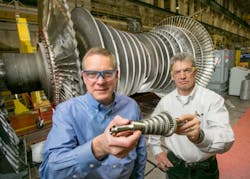GE conducting groundbreaking research linking power generation with water desalination
NISKAYUNA, NY, Nov. 11, 2015 -- As part of a new program with the U.S. Department of Energy (DOE), GE researchers at the company's Global Research Center in Upstate New York are conducting studies to further find the commonalities between power generation and water desalination. In power plants, steam turbines use pressurized steam to spin their rotating parts and power generators to produce electricity.
As part of the water desalination technology being developed with the DOE, researchers are using steam turbine turbomachinery 3D-printed in a miniaturized form to compress and stream a mixture of air, salt and water through a hyper-cooling loop that freezes seawater. By freezing the mixture, the salt naturally separates in solid form, leaving just the ice. The ice is then melted, leaving clean water.
Vitali Lissianski, chemical engineer and project leader at GE Global Research's Energy Systems Lab, explained that "97.5 percent of the earth's water supply is virtually inaccessible because water desalination is still too expensive and difficult to deploy at a large scale. By putting desalination 'on ice,' we hope to change that dynamic. Freezing seawater to treat it is nothing new, but the way we are doing it is very different. We're tapping into our wealth of technical knowledge in turbomachinery to devise a cost-effective solution."
The technology development brings together GE expertise in water desalination and turbomachinery. "GE's expertise with multiphase flowsin steam turbines is a foundation for the development of a turbine for desalination technology," said Douglas Hofer, who is leading the development of the turbine technology.
Hofer explained that in a low-pressure steam turbine, water vapor (steam) condenses to liquid water. For the new desalination process, the GE team is extending that idea to freeze liquid salt water into solid ice and salt crystals during its expansion through the turbine. This extension from condensing liquids to freezing solids requires new and innovative solutions to address several challenges of this new turbine application.
"Cooling the salty water, or brine droplets, by expanding cold gas in the turbine would greatly reduce the energy required for desalination," said Hofer. "The heat transfer between the cooling gas and brine would be much more efficient compared to conventional thermal desalination systems."
Lissianski added, "Support from US DOE is critical to the success of the technology development.Through our program with the DOE, we will test the feasibility of a low-cost water desalination system that is driven by our steam turbine parts and technical know-how. If it works, the process we are developing could reduce the cost of desalination by 20 percent versus more conventional thermal evaporation approaches."
See also:
"GE white paper highlights water reuse, recycling options for water-scarce regions"
"GE Water Business earns Safety Excellence Award for efforts at Ohio plant"
###

